CGKB News and events Rice
Cultural practices for characterization of wild rice
Contributors to this page: T.T. Chang Genetic Resources Centre-IRRI, Los Baños, Philippines (Ruaraidh Sackville Hamilton, Ken McNally, Flora de Guzman, Renato Reaño, Soccie Almazan, Adelaida Alcantara, Elizabeth Naredo); WARDA, Cotonou, Benin (Ines Sánchez); UPLB-University of the Philippines at Los Baños (Teresita Borromeo).
Wild rice is best characterized during the seed regeneration process. So the following cultural practices are the same as the regeneration guidelines of wild rice.
Choice of environment and planting season
Climatic conditions
- Most accessions of wild rice require different cultural management practices for seed increase compared to those of the cultivated rices.
- During plant growth it is necessary to simulate the habitat/growing environment of the original collection sites of each of the species to promote flowering.
- Cultural practices should be integrated with intensive monitoring of pests and diseases.
- Several species such as O. meyeriana, O. granulata, O. ridleyi and O. longiglumis grow better under partial shade, while others like some of the O. sativa complex grow well under full sunlight. These are usualy found in wet or seasonally wet habitats.
- Grow the plants in 30 cm wide-mouthed pots without holes, so they can be placed in different levels of shade in the screen house.
Planting season
- Most of them are strongly photoperiod-sensitive so that the best time to grow them is during a season with short daylength to induce panicle initiation.
- Planting of wild rice should be planned so that plants reach the reproductive stage when the shortest day length occur. In the Philippines they should be planted during the wet season (June) so that they have the reproductive stage during the shortest days that occur in December.
Preparation for regeneration
When to regenerate
The frequency of regeneration is determined by the quantity of seeds stocks left at the genebank.
The selection of material for planting depends upon the available space in the screen house facility as space is usualy a limiting factor.
- When stocks are insufficient.
- When viability reachs low or zero values.
- When seed samples are infected.
- When morphological characterization is scheduled.
- When there are small seed quantities from newly received samples.
- When there are highly heterogenous samples.
Propagation method
- Wild taxa are readily propagated by seeds.
- Some species like O. schlechteri are maintaned asexually through its vegetative stolons.
- O. longistaminata is maintained asexually with its rhizomes.
- Other perennial species can also be propagated by separating tillers of its vegetative crown.
Breeding system
- Rice is self-pollinated but some wild species have some degree of out-crossing.
Isolation
- Artificial barriers like net bags or glassine bags should be used to control inter-accession pollination.
- Net fencing using net curtains should be constructed to separate species like O. longistaminata.
- Pots should be planted with alternating species of different complexes.
Pre-treatments
Wild species are known to have stronger dormancy than the cultivated species. They may require one or a combination of dormancy breaking treatments including heat treatment, dehulling, exposure to alternating temperatures and, in some cases, chemical treatments.
Heat treatment
- In most species, heat treatment at 50°C for 10-14 days, followed by acclimatization at room temperature for 5-7 days is done before hull removal to promote germination of newly harvested seeds.
- If seeds are withdrawn from storage facility, allow 2-3 days for the seeds to adjust to room temperature before applying heat treatment.
- For species belonging to O. sativa complex, exposure to alternating temperatures of 45ºC and 30ºC (45/30) is generally effective in breaking dormancy. It is recommended, however, that the seeds be transferred to 30ºC after radicle emergence to achieve maximum seedling growth.
Dehulling
- Seed hull removal is recommended for most species to effectively break seed dormancy, but it is labour intensive and demands great care as not to damage the seed embryo.
- Treat dehulled seeds with a fungicidal suspension and wash thoroughly.
- Germinate on moist filter paper in petri dishes and place inside a germinator with 30°C and 100% RH.
Chemical treatment
- For some species, chemical treatment and/or dry heat method are more applicable and efficient when handling a large number of samples.
Method of regeneration
Sowing method
- Plant the germinated seeds 1-2 cm apart, in a seed box containing moist, fine, clean (preferably sterilized) soil mixed well with appropriate amount of ammonium sulfate.
- Apply a granular insecticide (e.g. Furadan) 3-4 days after planting to protect the seedlings from ants and other insects.
- Water the seedlings carefully with a fine spray, and grown them under partial shade until a week before transplanting.
Transplanting
- Transplant the seedlings 30 days after sowing to water-tight pots with good quality soil mixed with about 5 g of complete fertilizer.
- Maintain the water level to at least 1-2 cm depth.
- A granular insecticide (e.g. Carbofuran) should be applied 7 and 14 days after transplant to protect the plants against hoppers and defoliators.
Planting layout, density and distance
- Use 5-10 pots for highly heterogeneos populations with low seed-set samples.
- Otherwise, 3-4 pots are enough to produce seeds for storage.
- Pots should be laid out at least 100 cm apart to provide sufficient ventilation between plants and enough space for plant management, but preventing from constant humid conditions that are conducive to disease development.
- When pure lines are to be developed, only one plant per pot should be maintained and spaced widely, preferably alternating species of diferent complexes.
- If a bulk population is required, 2-3 seedlings per pot should be transplanted and all plants maintained.
Planting conditions
- For species of the O. meyeriana complex, the seedlings should be transplanted into pots with light soil and good internal drainage to prevent water logging as they thrive best in mesophytic conditions.
- For the highly stoloniferous species, such as O. schlechteri and some related genera like Luziola, Leersia, and Hygroryza, a modified flat bed should be constructed and used for growing and maintaining a single accession.
- All species of the genus Oryza grow well under full sunlight except members of the O. meyeriana complex and O. ridleyi complexes which are best maintained in partial shade.
- Accessions difficult to germinate should be cultured on agar, and seedlings raised in culture solution in the Phytoron facility, where growth environment can be modified, before transfer and reared in the screen house.
- For the highly photo-sensitive species like O.schlechteri, continued modifications of conditions for flower induction may be needed.
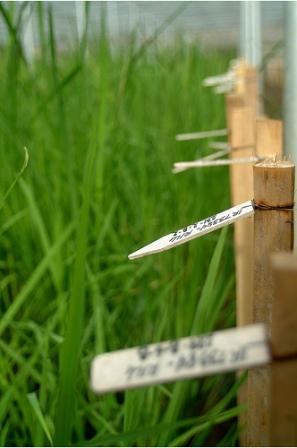 Different varieties of rice being grown inside an IRRI green house (photo: IRRI) |
Crop management
Fertilization
- Top dressing is recommended at 30 and 45 days after transplant with 5 g ammonium sulfate per pot.
- For O. meyeriana complex, 2 g of ammonium sulfate should be applied weekly during three weeks, 30 days after transplant.
Irrigation
- Plants should be watered daily, maintaining at least 1-2 cm depth.
Pest and disease control
- Plant health should be monitored closely and regularly, with seed health unit inspectors, as well as representatives from governmental health offices.
- Appropriate and intensive control measures should be applied to specific pest and diseases once symptoms appear.
- Spray liquid insecticides (emulsifiable concentrate and/or wettable powder) when need arises.
- Spraying soap detergent can help to control some small sucking insect pests.
- Maintaining the cleanliness of plants also helps preventing the spread of diseases.
- Infected/diseased plants should be rouged and eliminated.
Thinning
- When purelines are to be developed, only one plant per pot should be maintained and spaced widely, preferably alternating species of different complexes.
- If a bulk population of seeds is required, 2-3 seedlings per pot should be transplanted and all the plants should be maintained.
Harvesting
Panicle bagging
- At the late vegetative stage, (about 60 days after transplant) the tillers should be tied loosely with for example an abaca twine to a bamboo stake (5 cm x 2 m) to prevent plants from encroaching from one pot to another, at the late reproductive stage, to facilitate panicle bagging.
- Panicle bagging is necessary for handling wild rices to minimize outcrossing, to prevent seed loss due to shattering and to prevent mixtures at harvesting.
- Panicles should be bagged a week after full panicle emergence using nylon net bags, which provide ample ventilation to facilitate anther dehiscence and prevent mold formation on glumes.
- For species with shorter panicles, glassine bags are a good substitute.
- The net bag should be pinned to the bamboo pole.
- Prior to bagging, labels should be prepared using shipping tags written with plot number and date of bagging with indelible ink.
- The labels must be attached inside the net bags.
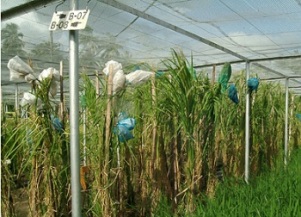 Rice being grown inside an IRRI screen house. Notice the bagged panicles (photo: IRRI) |
Panicle harvesting
- The panicles should be harvested 30 days after bagging or when most of the seeds have shattered.
- If sufficient seeds are obtained, the plants should be discarded and disposed through burning.
- However, for species with low seed set like O. rufipogon and O. longistaminata, the plants should be ratooned by cutting about 20-25 cm from the culms base, a little amount of ammonium sulfate should be applied and plants should be maintained until the next flowering to maximize seed production.
Post harvest management
Seed processing
- After harvesting, the panicles should be dried slowly to 6% moisture content and kept inside a drying room (15oC and 15% RH) for about 2-4 weeks.
- Seeds should be authenticated and cross-referenced against the seedfile before carefully hand threshing and cleaning.
- A 20 grain sample should be taken for seed viability testing.
Disposal of contaminated material
To ensure plants do not spread by seeds or rhizomes, specific measures should be followed:
- Carry out the seed multiplication of all wild rices inside the screen house in pots.
- Quarantine measures should be strictly followed to further minimize dissemination of seeds or rhizomes.
- Designate a disposal area (a pit about 3-4 m deep from the surface ground) for burying discarded and burnt samples to properly control spread of seeds or rhizomes.
- Provide a modified incinerator or burning facility to accommodate burning activities especially during the rainy season.
- Cover all drainage canals inside the screen house with fine-mesh screens to further control dissemination of seeds through water.
- Waste material from the canals should be regularly hauled, burned and buried.
- If sufficient seeds are obtained, old plants should be discarded, burned and buried into the pit.
- Excess planting material (seeds, seedlings, rattooned tillers) should be collected, burned and buried after seeding, transplanting and/or replanting.
- Discarded soil used in growing should be treated with herbicide and buried in the designated area.
- Before filling up all the discarded material, the disposal area should be treated with a non-selective herbicide (e.g. glyphosate).
- Spray with herbicides to kill persistent species.
- Screen house staff should be advised to change their working clothes to minimize dispersal of seeds when they leave.
- Hand threshing and seed cleaning should be done in a specified room in the Seed Processing Area of the genebank.
- All dried leaves/straws, unfilled grains, mixtures and off-types must be collected, burned and buried.
- The access to screen houses should be regulated depending on the nature/importance of the visit.
Recording information
Consult the general rice characterization page for information about descriptors, or recording of information during characterization.
References and further reading
Borromeo TH, Sanchez PL, Vaughan DA. 1994. Wild rices of the Philippines. Philippine Rice Research Institute, Maligaya, Nueva Ecija, Philippines.
Chang TT, Vaughan DA.1989. Conservation and potentials of rice genetic resources. In: Bajaj YFS, editor. Biotechnology in agriculture and forestry. Springer Verlag, Berlin.
Hanson J. 1985. Practical Manuals for Genebanks: Procedures for handling seeds in genebanks. IBPGR, Rome, Italy. HTML version available from: http://www2.bioversityinternational.org/publications/Web_version/188/. Date accessed: 10 June 2010.
Lu BR. 1999. Taxonomy of the genus Oryza (Poaceae): Historical perspective and current status. IRRN 24.3. IRRI, Los Baños, Laguna.
Manual of operations and procedures of the International Rice Genebank. 2000. Genetic Resources Center, IRRI. Available here.
Naredo MEB, Juliano AB, Lu BR, de Guzman FC, Jackson MT. 1998. Responses to seed dormancy breaking treatments in rice species (Oryza L.). Seed Science and Technology 26:675-689.
Rao NK, Hanson J, Dulloo ME, Ghosh K, Nowel D, Larinde M. 2006. Manual of seed handling in genebanks. Handbooks for Genebanks No. 8. Bioversity International, Rome, Italy. Available in English (1.5 MB), Spanish (1.4 MB) and French (1.9 MB).
Reed BM, Engelmann F, Dulloo ME, Engels JMM. 2004. Technical guidelines for the management of field and in vitro germplasm collections. Handbook for Genebanks No. 7. IPGRI, Rome, Italy. Available here.
Sackville-Hamilton NRS, Chorlton KH. 1997. Regeneration of accessions in seed collections: a decision guide. Handbook for Genebanks No. 5. IPGRI, Rome, Italy. Available here.
Tateoka T. 1962a. Taxonomic studies of Oryza I. O. latifolia complex. Bot. Mag. Tokyo 75:418-427.
Tateoka T. 1962b. Taxonomic studies of Oryza II. Several species complexes. Bot. Mag. Tokyo 75:455-461.
Tateoka T. 1963. Taxonomic studies of Oryza III. Key to the species and their enumeration. Bot. Mag. Tokyo 76:166-173.
van Soest LJM.1990. Plant Genetic Resources: Safe for the future in genebanks. Impact of Science on Society 158:107-120.
Vaughan DA. 1989. The genus Oryza L. Current status of taxonomy. IRRI Research Paper Series 138, Manila, Philippines.
Vaughan DA, Sitch LA. 1991. Gene flow from the jungle to farmers. Bioscience Vol. 41(1):22-28.
Vaughan DA. 1992. The wild relatives of rice: A genetic resources handbook. IRRI, Los Baños, Philippines.
Vaughan DA, Chang TT. 1992. In situ conservation of rice genetic resources. Economic Botany 46(4):368-383.
Vaughan DA, Morishima H, Kadowaki K. 2003. Diversity in the Oryza genus. Current Opinion 6:139-146.
Seed bank for wild rice and related genera genetic resources
Contributors to this page: T.T. Chang Genetic Resources Centre-IRRI, Los Baños, Philippines (Ruaraidh Sackville Hamilton, Ken McNally, Flora de Guzman, Renato Reaño, Soccie Almazan, Adelaida Alcantara, Elizabeth Naredo); WARDA, Cotonou, Benin (Ines Sánchez); UPLB-University of the Philippines at Los Baños (Teresita Borromeo).
When it should be used
Conservation of rice seed material under cold (between 2 and -20oC) and dry (moisture content of 6-7% fresh weight) storage is the most common, efficient and cheapest means of conservation of rice genetic resources. There are about 20 000 samples of wild rice seeds and related genera conserved in seed banks worldwide. The largest collections of wild rice and related genera are housed at CAAS, China and IRRI, the Philippines.
- Should be used for any rice accessions and species that produce seeds that remain viable under the standard cold and dry seed storage conditions.
Sample processing in seed banks of wild rice and related genera genetic resources
Contributors to this page: T.T. Chang Genetic Resources Centre-IRRI, Los Baños, Philippines (Ruaraidh Sackville Hamilton, Ken McNally, Flora de Guzman, Renato Reaño, Soccie Almazan, Adelaida Alcantara, Elizabeth Naredo); WARDA, Cotonou, Benin (Ines Sánchez); UPLB-University of the Philippines at Los Baños (Teresita Borromeo).
|
Contents: |
Cleaning is the removal of physical contamination from the plant material after harvesting, before it can be stored. The exposure to unfavourable conditions should be minimized for greater seed longevity in storage.
- Immediately after harvesting, the panicles should be dried (see details below) and kept inside the drying room for two weeks.
- Wild species are highly shattering thus panicles should be bagged to collect the seeds.
- Then they should be carefully hand threshed (this is necessary to maximize seed production) and cleaned.
Visual inspection of seeds
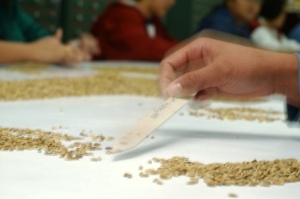 IRRI staff selecting good seeds for storage to the IRRI Genebank facility (photo: IRRI) |
- Verify the sample comparing it with the seed file.
- Determine the selection to be carried out based on the recommendation during the verification process.
- Examine the seeds and hand sieve them with graded mesh sizes (if mixtures/off-types vary in size) to separate slender and bold grains (manual cleaning limits contamination and damage especially when the seeds are very dry).
- Remove discolored, deformed, infected, soiled, immature, damaged, germinated seeds and off-types.
- Determine the actual action to be taken based on the quantity of clean seed (this will determine the packing system to use).
- Prepare and label all the necessary envelopes for use in seed testing, viability testing and for storage in the base, active and temporary storage.
- Submit the selected samples together with the seed file, pre-labelled envelopes and the original seed container for double checking and quality control.
- Check the selected sample against the seed file and the pre-labelled envelopes against the original container (to minimize labelling errors).
- Mix the selected samples and divide using the pre-labelled envelopes as follows in order of priority:
For base collection
- 100 grains or sufficient to plant them twice.
For active collection
Bulk sample for active collection.
- 100 grains.
For black-box safety backup storage:
- 2 x 100 grains for safety backup storage (one for Svalbard and one for another recognized genebank with long-term store accepting black-box safety backups).
For temporary storage
Often samples of wild rice do not produce sufficient material especially when there are limited incoming seeds.
- Place the cleaned samples again in the drying room.
- Regenerate when possible to obtain greater amounts of seed that would be sufficient for storage.
Disposal of contaminated material
This is important for discarded material, either from incoming samples or after harvest. Wild rice species are classified as noxious or invasive species, subject to rigorous biosafety containment procedures during all the stages of sample handling.
- All wild rice plant parts should be treated as if contaminated and processed in contained facilities separate from cultivated rice.
- All dried leaves/straws, unfilled grains, mixtures and off-types should be collected, burned and buried.
- A disposal area (a pit of about 3-4 m deep from the surface ground) should be designated for burying discarded and burnt samples.
- A modified incinerator or burning facility should be provided to accommodate burning activities especially during the rainy season.
Inspection and certification (purity analysis of seeds)
- Retrieve the accession number of all the harvested material.
- Retrieve the corresponding seed files (seed file provides information of the sample composition and guides the selection process).
- Determine and compare the composition of the harvest with the seed file or the remnants of the planting material if the seed file is not available.
- Identify the obvious mixtures/off-types, if present.
- If the harvest does not represent the original sample, trace back for possible errors.
- If there are doubts on the sample composition, place the harvest on hold and repeat planting, making additional observations during the growing period especially on the traits that differ in the initial harvest.
- Genotype the DNA if needed.
- If the new seed lot does not totally represent the original sample, discard the seed and record WH (Wrong Harvest) as the harvest status in the documentation system.
Note
Certain changes in seed phenotype may occur even though the seeds remain genetically true-to-type:
- Seed introduced from other environments may produce grain of different size in the seed multiplication environment.
- Hull pigmentation is more intense when grown under moist conditions.
- Harvests from screen house and field differ in hull colour intensity.
Methods
1st stage of drying (during cleaning)
- Immediately after threshing, place the seeds in net bags and store in a drying room maintained at 15oC and 15% RH.
- Spread the samples evenly on the drying shelves.
- Mix the samples by turning the bags daily.
- Monitor the moisture level.
- Transfer the dried samples to paper bags when the moisture is less than 10% MC.
2nd stage of drying (after cleaning)
- After cleaning, and sub-sampling for testing, place the selected samples back in the same drying room for 1-2 weeks while waiting for the viability and seed health results (during the seed selection process, seeds take in moisture).
- Test the moisture content.
- Monitor conditions in the drying room (with pre-set humidity and temperature, moisture testing is needed only infrequently. Test more often if fluctuations in RH are observed).
Alternative drying
- If facilities are not available for drying at 15oC and 15% RH or if the drying equipment is not working reliably, dry with self-indicating silica gel in moisture-proof containers.
- Repeatedly replace the silica gel until it stops absorbing moisture.
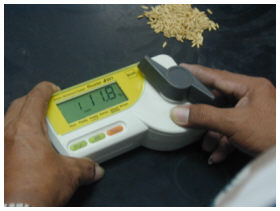 Using a moisture meter to check the moisture content of seeds (photo: IRRI) |
Drying time
- Minimum three weeks.
Moisture content before drying
- 9-20%.
Moisture content for storage
- 6-7%.
Critical moisture content
- 8% (below this level no insects or fungi affect the seed).
Determination of moisture content
- Wild rice species often have very few seeds in stock, therefore it is not recommended to perform any moisture content tests.
Recording information during seed cleaning and drying
The following information should be recorded for each processing step:
- AccID [Unique Genebank Accession ID. Note a technical distinction between accession number and accession ID. A number, unique within a collection, (the accession number) is often used by genebanks and is sufficient for genebank management purposes. However, for all public documentation that number should be prefixed with a code to identify the collection and thus create an ID that is unique across genebanks: the combination of prefix and accession number then is a public accession ID].
- Cropping season (year and season of seed multiplication).
- Germination % (two replications; initial % of germination of freshly prepared seed).
- Germination date (date of germination test).
- Packaging date (month and year of packing).
- Amount_bulk [amount (g) stored in bulk package in the active collection].
- Number_paper packs [number of paper packs retained for repeat multiplication – (for temporary storage only, if the viability or Seed Health tests result is below the acceptable limit)].
- Number_apack (number of small aluminium foil packets for storage in the active collection, pre-packed with 10 g dried seed ready for distribution).
- Amount_base [amount (g) stored in base collection].
- Plant_material (sufficiency of planting material for harvests that requires another round of seed multiplication).
- No. of Rows (approximate number of rows that could be planted for seed multiplication using the available planting material).
- Harvest_status [status of harvest (Insufficient, Mixed, Diseased)].
- Active tray ID (ID of the tray where the sample is stored in the active collection).
- Base tray ID (ID of the tray where the sample is stored in the base collection).
- Amount for duplicate storage1 (mark X if a sample has been prepared for the primary black-box safety duplicate storage genebank).
- Amount for duplicate storage 2 (mark X if a sample has been prepared for duplicate storage in Svalbard, Norway).
- Insects and pests (degree of insect and fungal damage).
Viability of wild rice and related genera genetic resources
Contributors to this page: T.T. Chang Genetic Resources Centre-IRRI, Los Baños, Philippines (Ruaraidh Sackville Hamilton, Ken McNally, Flora de Guzman, Renato Reaño, Soccie Almazan, Adelaida Alcantara, Elizabeth Naredo); WARDA, Cotonou, Benin (Ines Sánchez); UPLB-University of the Philippines at Los Baños (Teresita Borromeo).
|
Contents: |
Laboratory methods
Type of test
- Standard germination test (modified from ISTA methods).
Number of seeds and replicates
- Active and base collections: 20 seeds with 1 or 2 replicates, depending on the amount harvested (some species may not produce enough seeds for storage; some of them may be highly sterile).
Pre-treatment
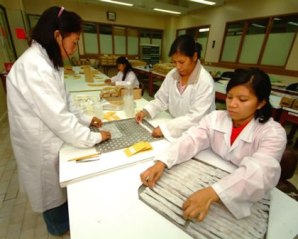 Viability is tested initially by placing seeds under conditions conducive to germination and recording the percentage that germinates (photo: IRRI) |
Wild species generally have stronger dormancy than cultivated species and differ widely in response to procedures for breaking dormancy.
- Depending on the species, one or a combination of dormancy-breaking treatments including heat treatment, dehulling, exposure to alternating temperatures and, in some cases, chemical treatment.
- Treat dehulled seeds with fungicide (dehulled seeds are more susceptible to fungal attacks).
Media
- Use Petri dishes lined with moistured paper.
Temperature/ Humidity
- 30oC and 100% RH.
Light
- 12/12 hours light/dark.
Duration of test
- 7-28 days.
Monitoring intervals
- No monitoring should be done during storage (most stocks do not have sufficient stocks for routine monitoring).
- The longevity of wild rice in storage is generally high.
Recording information during viability testing
The following information should be recorded for each testing step:
- Germination date (date of germination).
- No. Tested (number of seed tested).
- % germination rep 1 (germination % in replication 1).
- % germination rep 2 (germination % in replication 2).
- % germination mean (system-calculated mean for the % germination).
- Germination retest (germination % of the retested sample).
- Accession (list of accessions tested).
- Date counted (first count at 7 days and second count at 14 days).
- Normal seedling (seedlings that are free from decay, have well-developed primary root systems, have well-developed and intact coleoptiles).
- Abnormal seedling (seedlings not well developed).
- Assumed dormant seeds (hard but non-germinated seeds).
- Dead seeds (rotten seeds).
- Germination % (the percentage of normal seedlings).
Methods
Minimum viability
- This is not monitored for wild rice due to generally low stocks of seeds.
Minimum quantity
- Each time an accession is removed from storage, for whatever purpose, weigh again and update the computerized inventory before replacing the accession back in storage.
- Use barcoded labels with computerized inventory management system linking the balance to the database.
- If the quantity remaining is less than 60 g, mark the accession in the database as unavailable for distribution and schedule it for regeneration.
Monitoring frequency
This section recommends the minimum quantity and minimum viability of seeds below which they need to be regenerated.
Critical quantity
- 100 grains (twice the amount needed for a regeneration planting).
Critical germination level
- Not applicable for wild rice (dormancy is very hard to break for some spp.).
Recording information during routine monitoring
The following information should be recorded for each step:
- Accession ID (ID of accession).
- Seed Lot ID (ID of this sample of the accession).
- Crop season (year and season the seed was harvested).
- Store – temporary, active bulk, active pre-pack, base, primary safety backup, secondary safety backup (type of storage and packing for this sample).
- Species (the scientific name of the species).
- Germination % (two replications) (germination % - separate values for each replication; new record for each test).
- Germination test No. (number of seed per replicate used for testing germination %).
- Germination date (date of germination test; new record for each test).
- Seed amount units – grams, number of packets (units used to record the amount of seed of this sample).
- Seed amount (amount of seed in store; new record for each update).
- Inventory date (date the amount was last updated; new record for each update).
Note: Health diagnosis (testing) is not recommended during storage of wild rice, due to the usually limited number of seeds in storage.
References and further reading
Naredo MEB, Juliani AB, Lu BR, Guzman F, Jackson MT. 1998. Responses to seed dormancy-breaking treatments in rice species (Oryza L.). Seed Science and Technology 26:675-689.
More Articles...
- Storage of wild rice and related genera genetic resources
- Field bank for wild rice and related genera genetic resources
- Sample processing and viability in field banks (wild rice and related genera)
- Regeneration guidelines for wild rice and related genera
- Sample processing in seed banks of cultivated rice genetic resources
- In vitro bank (cultivated rice, wild rice and related genera)
- Storage of cultivated rice genetic resources
- Distribution of cultivated rice, wild rice and related genera genetic resources
- DNA bank for cultivated rice, wild rice and related genera genetic resources
- Registration of cultivated rice, wild rice and related genera genetic resources
Subcategories
-
main
- Article Count:
- 1
-
Regeneration
- Article Count:
- 3
-
Conservation
- Article Count:
- 1
-
Safety duplication
- Article Count:
- 1
-
Characterization
- Article Count:
- 3
-
Conservation - Wild Rice
- Article Count:
- 7
-
Conservation - Cultivated Rice
- Article Count:
- 13




